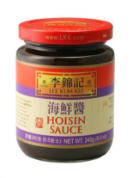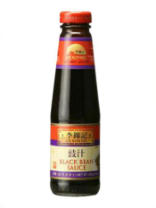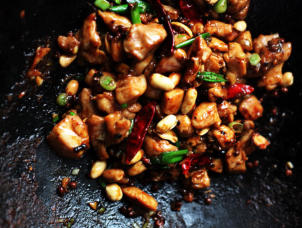Kung Pao Chicken
By Suzanne Corcoran,
Kung Pao is easier than you think, with a couple of special ingredients you can get at an Asian grocery store.
Ingredients:
- 8 ounces chicken breast, cut into very small cubes ½ inch or less
- 1 teaspoon cornstarch
- ½ cup peanut oil
- 6 dried chili peppers, or 1 teaspoon red pepper flakes, or to taste
- 2 tablespoons bean sauce
- 1 ½ tablespoons hoisin sauce
- 1 tablespoon rice vinegar
- 1 tablespoon soy sauce
- ¼ cup scallion whites, sliced thin
- 3 garlic cloves, peeled and chopped fine
- ¼ cup roasted unsalted peanuts



Kung Pao Chicken with Hoisin Sauce
Kung Pao Shrimp or Scallops
Home | Indian Recipes | Thai Recipes | Main Dishes | Desserts | Leave a Comment | Recipes by Email | About
Copyright © Suzanne’s Recipe File | Privacy Policy

Okay, so this is not a Thai recipe, but I have to include it because it is so good. I have tried to make Kung
Pao chicken many times without success. Many of the recipes I tried actually called for marinating the chicken in
red wine or sherry wine which gave the chicken an
unnatural color. Today I use this recipe which my
family loves.
The secret to a good Kung Pao sauce is the
bean sauce, hoisin sauce and rice vinegar. You can view the full story behind the ingredients and the recipe
below….
Prepared bean sauce is made from pureed soybeans or black beans with added spices. It forms the base
of many Chinese dishes but many new cooks are not familiar with it. But is very easy to use because it comes
prepared in jars and you can try different brands to see which suits your taste.
Some people confuse hoisin sauce with plum sauce. Hoisin sauce is made from soybeans that have been
fermented and sweetened with sugar or molasses. Plum sauce really is made from plums and it is not a good
substitute here so be sure to use hoisin sauce for this recipe.
The word vinegar comes from the French words vin (wine) and aigre (sour). Plain white
vinegar is made from diluted alcohol products, usually wine, which have been forced to react with
oxygen. Chinese style rice vinegar is brewed from rice wine and so it is a less acidic product and
that is why it is used here. So you can see how the terms rice vinegar and rice wine vinegar are
interchangeable in the grocery store.
Ingredients for marinating the chicken:
8 ounces chicken breast, cut into very small cubes ½ inch or less
1 teaspoon cornstarch
½ cup peanut oil
For the Sauce:
6 dried chili peppers, or 1 teaspoon red pepper flakes, or to taste
2 tablespoons bean sauce
1 ½ tablespoons hoisin sauce
1 tablespoon rice vinegar
1 tablespoon soy sauce
¼ cup scallion whites, sliced thin
3 garlic cloves, peeled and chopped fine
¼ cup roasted unsalted peanuts
Optional:
2 celery stalks, chopped
2 medium carrots, sliced, then boiled until they are just tender, then drain them and they
are ready for this recipe 6 broccoli florets You can also replace the chicken with more
vegetables for Kung Pao Vegetables, or substitute some seafood to make Kung Pao
Shrimp or Kung Pao Scallops.
Start by marinating the chicken breast with the corn starch and oil, and let it sit for at least
30 minutes.
Heat a wok or a heavy skillet, then add the chicken and cook until the meat changes color.
Then remove just the chicken and set it aside. If you are using shrimp cook them until they turn pink, and for
scallops cook them until they just start to turn a solid white color and immediately remove them. Drain and set
aside any cooked meat you have for now.
Pour off all but ¼ cup of the oil from the wok. If you have used frozen meat then there will have been extra
water released during cooking. Just leave only ¼ cup of the oil and fluid in the wok and drain off all the rest and
discard it.
Add the dried chilies, the scallion whites and garlic and stir fry them all briefly. Then add any vegetables
you are using like the optional celery, carrots or broccoli and cook them just until they are heated through.
Now add the sauce mixture, and cook until it just begins to boil, then add the chicken or other cooked meat
and toss to coat everything and serve with rice!
You can double or triple this recipe but if you do then keep the amount of oil the same, or just increase it a
little. Also, increase the amount of sauce only just a little because for me for some reason the sauce gets out of
proportion when I double or triple this recipe.

►Home- All Recipes
►Thai Recipes
►Stir Fry Greens
►Pad Thai
►Pad See Ew
►Lao Style Crispy
Rice Salad
►Lemongrass Soup
►Nasi Goreng
►Chicken Satay
►Thai Steak
Marinade
►Thai Chicken
Salad
►Glass Noodle
Salad
►Beef Salad
►Pasta Salad and
Peanut Sauce
►Green Papaya
Salad
►Ginger Salad
►Steamed
Dumplings
►Spring Rolls
►Spring Roll
Dipping Sauce
►Chicken with
Basil
►Panang Peanut
Curry
►Red Curry with
String Beans
►Thai Curry from
Scratch
►Moo Shu
Chicken
►Kung Pao
Chicken
►Leave a
Comment
►Get Recipes
by Email





- Pad Thai
- Spring Rolls
- Spring Roll Dipping Sauce
- Lemongrass Soup
- Glass Noodle Salad
- Lao Style Crispy Rice Salad
- Chicken Satay
- Green Papaya Salad
- Pasta Salad and Peanut Sauce
- Thai Chicken Salad
- Ginger Salad
- Stir Fry Greens
- Steamed Dumplings
- Nasi Goreng
- Red Curry With String Beans
- Pad See Ew
- Thai Steak Marinade
- Thai Curry From Scratch
- Thai Beef Salad
- Chicken With Basil
- Panang Peanut Curry
- Kung Pao Chicken
- Moo Shu Chicken









